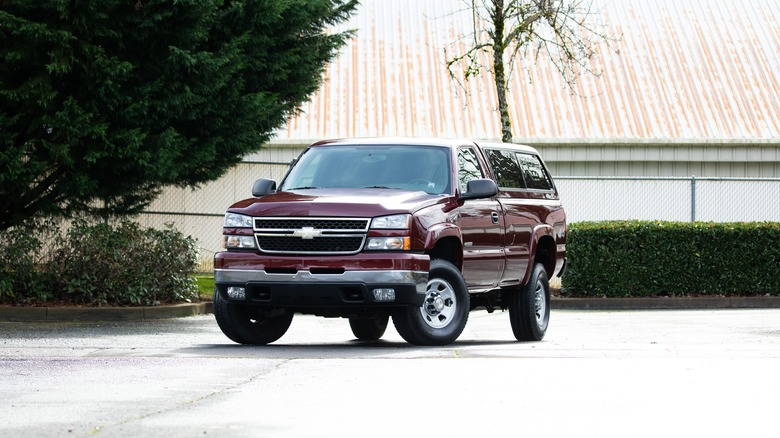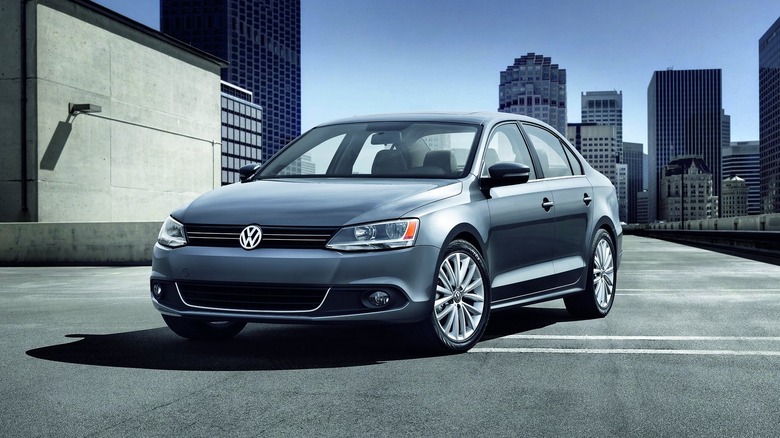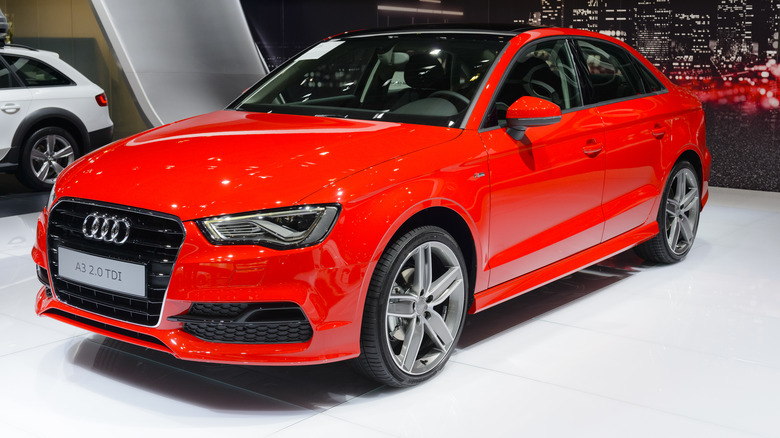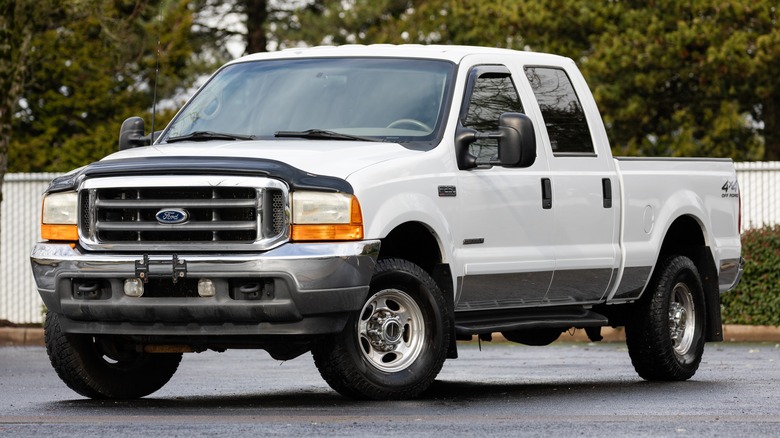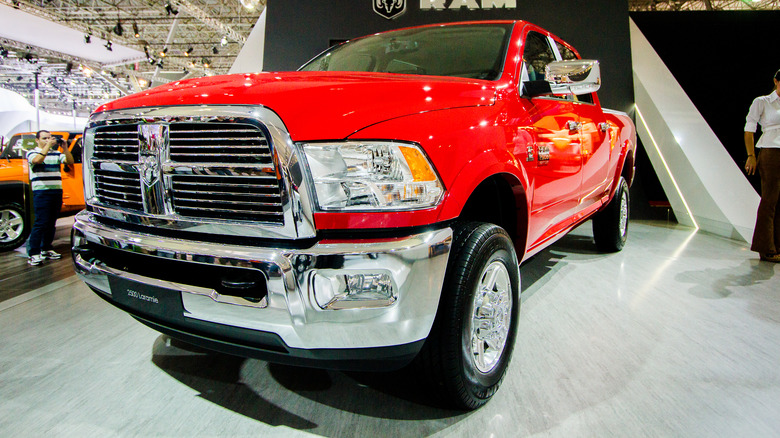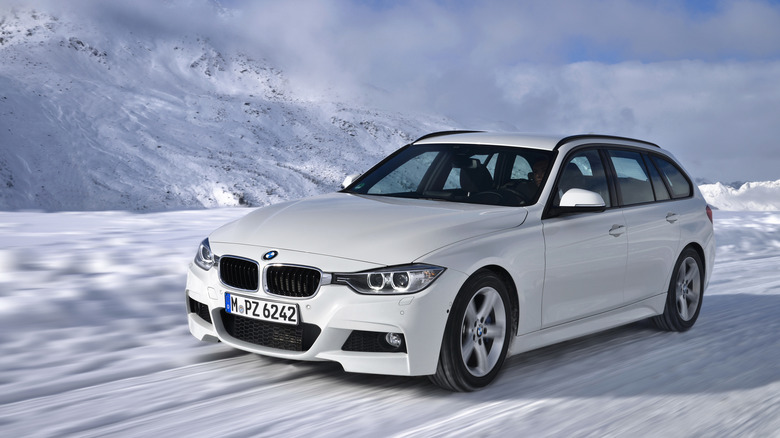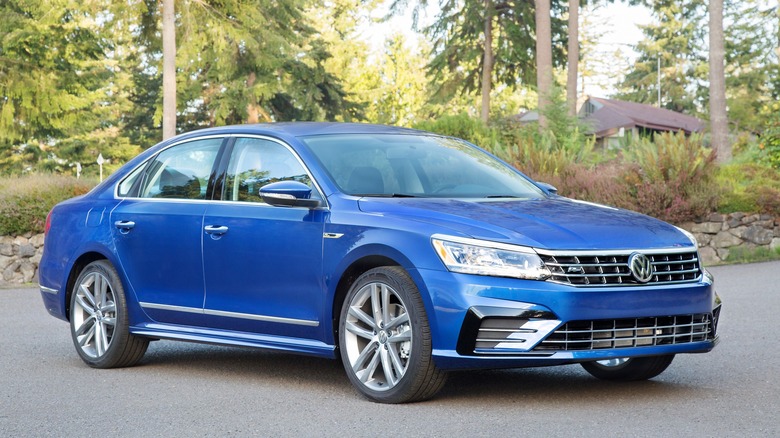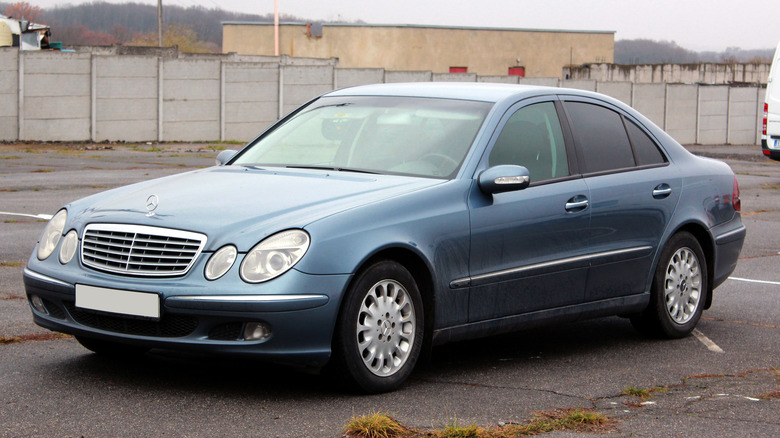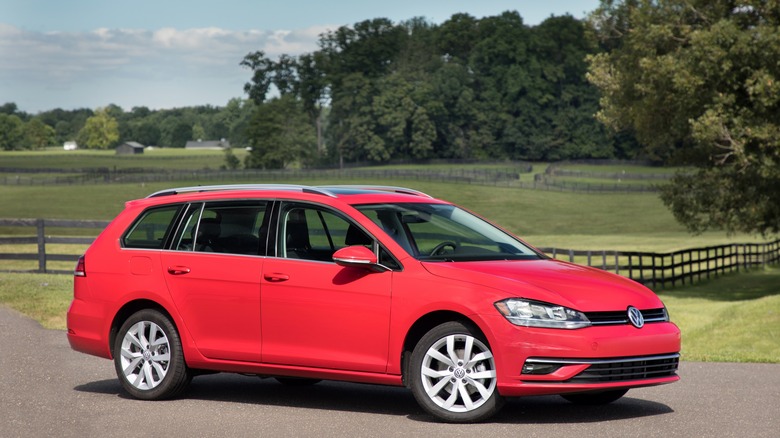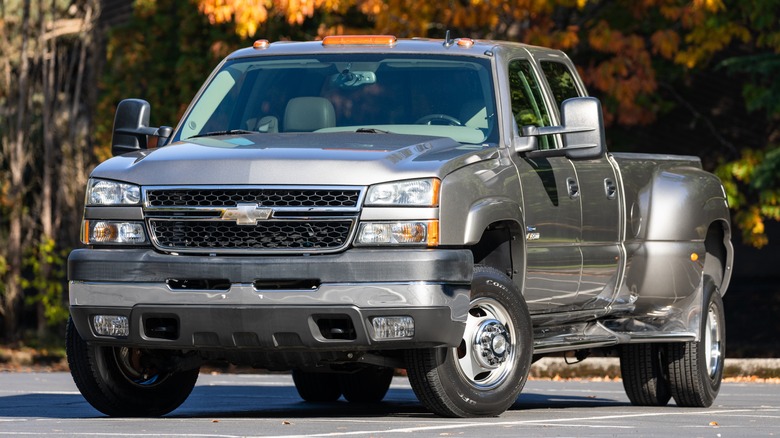9 Affordable Diesel Cars And Trucks You Can Buy In The US In 2024
Diesel is one enigmatic fuel. The engine technology was invented by Rudolf Diesel in the early 20th century, and it represented approach to internal combustion. Instead of sparks that cause ignition and allow combustion to happen, the diesel engine uses compression. Without getting too technical or complicated, the benefits of this design include more torque, better fuel economy and, in theory, lower emissions.
We all know how the Volkswagen Dieselgate scandal went, so lets set that last bit aside for just a moment. American automakers tried, and failed, to deliver a proper diesel-powered automobile in the '80s. However, diesel fuel did trickle into passenger cars in the U.S. and Canada for a short time, and it's been powering pickup trucks for the longest time.
Despite being seen as the dirty, undesirable fuel, a diesel-powered car or truck can actually do you a lot of good. There are some great affordable options on the market, and their gas mileage is actually very impressive. The trucks can tow and haul some pretty big things, too.
Volkswagen Jetta TDI (A6)
If the Golf is too small for you, and you don't want to quite stretch to the very largest Passat, the Volkswagen Jetta can plug that niche gap. It's been a huge hit in North America ever since its debut, but though it isn't quite as favorably viewed in Europe.
The A6 or Mk6 Jetta, obviously based on the Mk6 Golf, arrived for model year 2011 in North America. It was available with a pretty solid lineup of powertrains, including the North America-only 2.5-liter I5, which makes a lovely noise and is plenty powerful. However, VW also offered a 2.0-liter turbodiesel.
140 hp seems like it might not be enough, but the heaping helping of torque (236 lb-ft, to be exact) more than makes up for it. You could pair the TDI with either a six-speed manual transmission or a DSG dual-clutch automatic. This engine is torquey, sounds pretty good, and it's good to drive. It's very dependable if you take care of it properly. It's tough to argue with prices less than $10,000, and 34 mpg in combined driving and up to 42 mpg on the highway.
Audi A3 TDI Sedan
Volkswagen is often seen as the more premium of the affordable automakers in North America, but what if you want something more upscale than Golf or Jetta? That's where the Audi A3 sedan comes in. Introduced with the Golf-based hatchback's third generation, the sedan is a surprisingly attractive alternative to the standard A3.
Being an Audi, it's also a bit more upscale and premium-looking, plus it comes with badge bragging rights if that's something that you're into (you shouldn't be). Underneath the bodywork, the A3 shares its platform with the VW Golf, incidentally making it one of the only Audi models to have a transverse engine layout.
In North America, the A3 Sedan also came with the 140 hp 2.0-liter TDI engine, with the exact same 236 lb-ft of torque that the Jetta offered. That means, again, plenty of torque and a good amount of shove for what it is, but also stellar fuel economy and relatively cheap maintenance. The Golf underpinnings also mean that any other type of maintenance shouldn't completely drain your bank account. Speaking of, you can find an A3 Sedan TDI for around $15,000, and that's for the nicer ones.
Ford Super Duty 7.3 Powerstroke
For every good Powerstroke diesel from the Blue Oval, there were at least two bad ones. Ford truck people pretty much unanimously agree that the absolute peak of the Powerstroke family is the 7.3-liter unit introduced in 1994, developed in partnership with Navistar. One of Navistar's subsidiaries makes those military off-roaders that The Rock often drives in the "Fast & Furious" movies.
The 7.3 Powerstroke stuck around until the early 2000s, when it was replaced by the universally hated 6.0-liter Powerstroke. Thanks to some thoughtful, durable engineering and only as much power as was strictly necessary, the 7.3 Powerstroke is pretty much bulletproof. With proper maintenance, it's entirely possible to get close to seven figures on the odometer.
Not only that, but 7.3 Powerstroke-powered trucks are also very simple. Sure, segmented tailgates and trailer backups and power supplies in the bed are all very nice and helpful, but sometimes, you just want something simple. Any Ford pickup from the 90s and the 2000s, including the Super Duties, are refreshingly simple and easy to work on. Due to the 7.3's desirability, lower mileage examples have jumped way over the $20,000 mark. However, as long as the maintenance has been kept in check, slightly higher mileage Super Duties with the 7.3 can be found for less than $10,000.
Not just in terms of the engine, whose pushrod design makes it easy to service and fix up, but in general. The immense torque and durability also means that you can tow and haul just about anything.
RAM 6.7 Cummins
GM has Duramax, Ford has Powerstroke, and RAM has Cummins. RAM's partnership with one of the oldest, most celebrated names in the world of the diesel engine goes back decades, and RAM pickups equipped with diesel power still have the big C on their fenders. While there have been a fair share of Cummins engines in RAMs over the years, the 6.7 Cummins appears to have won over owners and mechanics alike.
One thing to look out for is the diesel particulate filter (DPF) and exhaust gas recirculation (EGR) systems, which were two necessary additions to help the engine comply with emissions regulations. Depending on how the previous owner has driven the truck, these can cause some issues. I can tell you from personal experience that regular driving on the highway at higher RPMs will circumvent any potential problems, but post-2013 RAMs are also less prone to these issues. For some reason, some of these are selling for well over $40,000, but you shouldn't be paying that much. $15,000 gets you a sorted base Tradesman, and around $25,000 should get you one of the higher, more well-appointed trim levels.
Early and mid-2010s RAMs can be found for good money, and while they are definitely more modern than, say, an early 2000s F-250, they are still a lot simpler, while still being comfortable and having a good amount of equipment. If you're a RAM person, a used 6.7 Cummins that's been properly maintained will treat you right.
BMW 328d (F30/F31)
Let's take a break from the pickup trucks. There's this unwritten rule that a BMW needs to have six or eight, sometimes 10 cylinders, and an M badge — usually both at the same time. However, BMW's catalog is full of excellent machines that have neither of those things, but are still fantastic. For proof, we have the F3x 328d.
Confusingly, it's not powered by a 2.8-liter diesel engine, but rather a 2.0-liter turbo four-cylinder unit. Essentially, it's what Europeans know as the 320d. The 320d is super popular all over Europe, and especially in Eastern Europe, and it's time it received some love in North America as well.
The 328d puts out a modest 181 hp, but like with any diesel, it makes up for it in torque — 280 lb-ft of the stuff, to be exact. This means it's great for towing and carrying around pretty big loads, the latter being especially important as you could pair this engine with the 3 Series Touring, which is one of many used cars you should be considering instead of an SUV. With a 0-60 time of around 7 seconds, it's also pretty brisk, but it can still manage up to 43 mpg on the highway. That's not the end of the plus points, either: Most of these came with AWD, and BMW's four-cylinder diesels tend to be pretty durable. Being a BMW, it's also good to drive and packed with great features.
If you're a risk taker, you can find a higher mileage 328d for less than $15,000, but for $20,000-$25,000 you should be able to get solid example that has been maintained properly.
Volkswagen Passat TDI
Let's say that neither the Golf nor the Jetta cut it, and you want the largest sedan that VW has to offer. The Passat may have been discontinued in 2022, but older models of the car still have a lot going for them. Up until 2012, VW sold the same Passat to Americans as it did to Europeans, but in 2012, the NMS Passat came along. NMS stood for new midsize sedan, and this Passat specifically catered to North American audiences.
It was significantly larger than any European Passat, and it prioritized being more affordable and more spacious. Engine options were plentiful, and even a VR6 was available. As part of VW's TDI push in the U.S. and Canada, the NMS Passat was also offered with a 2.0-liter TDI making 140 hp, and later 150 hp, and 236 lb-ft of torque.
It's essentially the same unit as the Jetta, and as mentioned previously, that's no bad thing. It's refined, smooth, fairly quiet, great on fuel, and surprisingly punchy, with a good amount of low-end torque. Sadly, this engine wasn't offered for very long (you can probably guess why), but it's a solid option for the Passat if you still want good gas mileage, along with decent power and torque. Assuming it's been maintained properly, a Passat TDI with over 100,000 miles is a sub-$10,000 bargain, but expect to pay a little more for one with five figures on the odometer.
Mercedess E-Class CDI / BlueTEC / BlueEfficiency
So the Jetta has the compact sedan crowd covered, the Passat has the mid-size sedan crowd covered, and the F31 has the compact wagon crowd covered. What about luxury sedans? The Mercedes E-Class is here to save the day. While Mercedes makes some fabulous gasoline engines, the three-pointed star's commonrail diesels are nothing to scoff at.
As well as CDI, the diesel-powered E-Class has also been marketed with the names BlueTEC and BlueEFFICIENCY (yes, in all caps, for some reason). North America only got the 3.0-liter V6 turbodiesel unit. While Mercedes from the 2000s and 2010s have a so-so reputation for reliability, the V6 diesels are always great if properly maintained — key words: properly maintained.
You're also pairing that up with a handsome, practical, and luxurious full-size sedan with plenty of space and more than enough features to keep you and your loved ones entertained and comfy. It's very unfortunate that Mercedes never offered the diesel engine on the wagon, but still, the E350 diesel is a nice change of pace that's easier on the gas bill, and a Mercedes in every other aspect. Depreciation has absolutely destroyed the diesel E-Class, as both W211s and W212s can be found for as little as $10,000, and often for less.
Volkswagen Golf TDI Sportwagen
While the F31 328d is a fantastic diesel-powered wagon, it's still a BMW. That means expensive and somewhat complicated maintenance, and that's not what everyone's looking for. If you want cheaper and simpler maintenance, but you can't give up diesel power and a wagon body, check out the Golf TDI Sportwagen.
VW offered the Mk6 Golf as a wagon in North America, badged as the Jetta Sportwagen. For the Mk7, however, the Golf branding was universal all over the world. In just about every aspect, the Golf TDI Sportwagen is the answer to wagon buyers' needs. Depreciation has been kinder to the Golf Sportwagen, as prices huddle around the $13,000 to $20,000 mark.
It's affordable on the used market, good to drive, has a fantastic powertrain with lots of torque and excellent fuel economy. It also won't make you feel like you've jumped back in time 15 years when you sit inside of it. It's a shame that the Golf Alltrack never came with the 2.0 TDI, because the Golf Sportwagen is a great family car that's easy on the wallet, while also being a car you can buy with both your head and your heart. And it's even bigger shame that Volkswagen discontinued the Golf Sportwagen in 2019.
Chevy Silverado 6.6 Duramax (LBZ)
To round off the pickup options (and the rest of the list), we have the Chevy Silverado. Similar to Ford's Powerstroke, Chevrolet's Duramax powertrains can be hit or miss. Some are better for all-out dependability, and some are very good if you want to squeeze extra power out of them. However, the GM community agrees that the best Duramax middle ground is the 6.6-liter unit, also known as the LBZ.
The LBZ carries one notable flaw, however: It was only offered for the 2006 and 2007 model years, powering the Silverado Heavy Duty, as well as the related GMC Sierra Heavy Duty. One thing that you can't fault the LBZ for is its stock power output: 360 hp and 650 lb-ft of torque is seriously impressive.
One of the main reasons why the LBZ is such a strong engine is its notable lack of emissions control and reduction equipment, most notably the absence of a DPF. DPFs are one of the main troublemakers in modern diesel engines, so right off the bat, you'll experience fewer issues with the LBZ compared to the later Duramax engines. Pistons were prone to cracking if you added more power, but if you keep it stock, the LBZ will do its job every time. Plus, simplicity and less things to go wrong are very much on your side here, too. Due to the demand, prices aren't quite as low, but still, $25,000 should get you a nice example of one of the most durable GM trucks from recent history.
